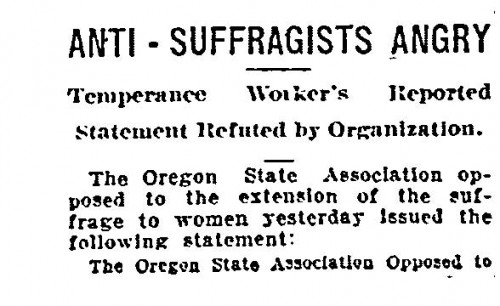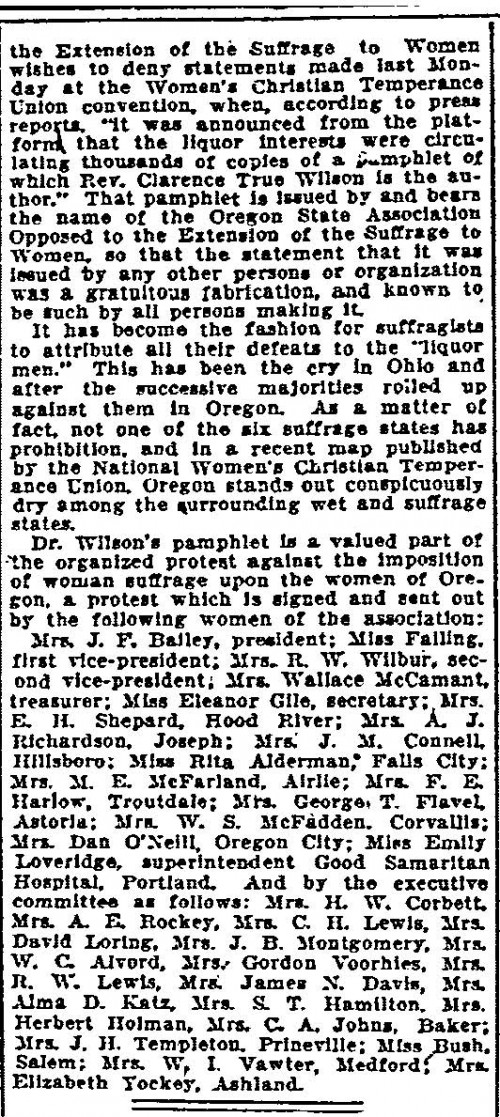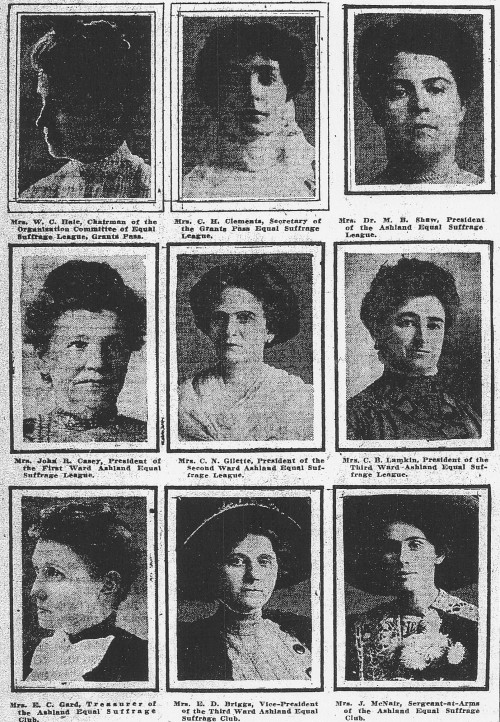“Women Formally Take Their Place in the New Order”: Suffrage Victory Banquet November 18, 1912
Suffragists around the state took their final action, then watched and waited as male voters cast their ballots on November 5, 1912. When the votes were counted, Oregon male voters had supported equal suffrage by 52 percent.
Portland suffragists planned for a victory banquet at the Multnomah Hotel on the evening of November 18 for some 300 people. They prepared with suffrage colors and “by special request of the women who are staunch advocates of ‘home products,’ the good things served will just as far as possible be ‘made in Oregon’ products.” Suffrage colors and a full program would round out the evening.


“Victory Banquet to be Celebrated by Suffragists,” Oregon Journal, November 17, 1912, 16.
The Oregon Journal named it a “jollification feast” in its announcement of the event on November 17. Governor Oswald West would be toastmaster. Abigail Scott Duniway had the seat of honor at the main table. Many toasts, evidence of strong preparation and the wish to honor those members across many coalitions who had supported the cause, were scheduled. They included “Our Appreciation” by Viola (Mrs. Heny Waldo) Coe; “The Press and the Industries,” E. Hofer; “Women’s Place in Politics,” Senator Harry Lane, MD; “The Work of Our Club,” Sarah A. Evans; “The Highways to the Home,” Samuel J. Hill; “Political Equality for the Nation,” John F. Logan; “College Work for Suffrage,” Emma Wold; “The Wars of the Ages,” Judge P.H. D’Arcy; “Greetings from the State of Washington,” George U. Piper; “The Roll of Honor,” Mrs. L. M. Hidden; “The New Era,” Eugene Brookings; “Our Victory,” W.M. Davis; “Political Equality,” Rabbi Jonah Wise; “Laws for Women—Its Progress,” W.H. Peterson; “The Coterie of States,” Robert Miller; “The Evolution of the Hour,” C.E.S. Wood; “The Social Status of Voting Women,” Dr. Esther Pohl Lovejoy; “Women’s Influence With the Ballot,” Lee Paget.
Two days later the Oregon Journal reported on the event with the declaration, “Women Formally Take Their Place in the New Order.”


“Women Formally Take Their Place in the New Order,” Oregon Journal, November 19, 1912, 21.
“It was a political banquet at which women were present,” the Journal noted, “yet there was no strained or unnatural note. Through it seemed to run a rare new feeling of comradeship between the sexes, finding expression in speech after speech and deeply prophetic of ever closer partnership in the mutual solution of political and social questions to come.”
Those present paid tribute to Abigail Scott Duniway, whose 42 year struggle saw its resolution that night. It was, the Journal noted, “the moment of realization of Mrs. Duniway’s life.” Governor West noted: “I am pleased to have had an opportunity to repay, to make a small repayment to the woman who gave me birth and to my wife, who has fought with me side by side in my battle in the world. And above all I am pleased because victory has come to the woman who begged, who argued, who pleaded and who fought. I am pleased that it has come while she is still alive and amongst us.”
Among others making toasts was Harry Lane, the newly elected Senator. “I extend to you my sisters congratulations. I have been with you at heart through all the struggle. I have the faith that you come among us as betterments to our government.”
The Journal concluded, “The banquet ended when a line of pretty girls, carrying flags representing the suffrage states, filed around to Mrs. Duniway’s place and circled about her, waving the banners gently above her.”
So ended a hard-fought struggle, and so continued Oregon women’s fight for complete female citizenship.
—Kimberly Jensen
Want to read more articles from Oregon suffrage campaigns? Click here
Permalink
October 1912: Eva Bailey and the Oregon State Assn. Opposed to the Extension of Suffrage to Women
I’m very pleased to introduce Diane Voltin who is serving as guest author for this month’s installment of This Month in Oregon Woman Suffrage History. Ms. Voltin was a student in Janice Dilg’s Winter 2012 capstone course at Portland State University titled Monumental Women. In the course students developed a walking tour of Portland that highlighted people and places important to the 1912 suffrage campaign. Ms. Voltin is a 2012 graduate of Portland State University with a degree in Social Science and with interests in history and geography.
In the following selection, Voltin invites us to consider the ideas and tactics of Eva Bailey and other Oregon women who opposed woman suffrage. She raises important questions about the nature of women’s relationship to the state and to citizenship as she investigates Bailey and other anti-suffragists in the 1912 Oregon campaign. She also gives us a glimpse of the sparring between supporters and opponents with a wonderful rebuttal of Bailey and the anti-suffrage position from Abigail Scott Duniway.
—Kimberly Jensen
The issue of temperance played less of a role in the suffrage fight in the 1912 election than it had in previous elections, but the “liquor interests” still loomed large concerning the issue. This letter to the editor of the Oregonian, signed by the elected title-holders and members of the Oregon State Association Opposed to the Extension of Suffrage to Women, refuted the claim made at the Women’s Christian Temperance Union convention that men who sold liquor had anything to do with the writing or distribution of an anti-suffrage pamphlet. While some women in Oregon were unwilling to have the vote “imposed” on them, women such as Eva Bailey, president of the Oregon State Association Opposed to the Extension of Suffrage to Women, demonstrated the ability of women to influence the political process in Oregon.


“Anti-Suffragists Angry: Temperance Workers Reported Statement Refuted by Organization,” Oregonian, October 24, 1912, 4.
The Oregon State Association Opposed to the Extension of Suffrage to Women was the organized and public face of the anti-suffrage movement. Their argument against granting suffrage to women in Oregon, as detailed in the 1912 Oregon Voter’s Pamphlet, was based on the belief that woman, “has done her part in the home and not on the hustings, and her power for good is the greater because she has been content to be a woman and has not striven to be an imitation man.” (Oregon Secretary of State, Voters Pamphlet for the General Election, 1912 [Salem: Oregon State Printer, 1912], 7.) Anti-suffragists cautioned that granting the vote to women might give women the appearance of being more like men on a surface level, but stressed that doing so should not be confused with actually making women equal to men, which anti-suffragists considered a fundamental impossibility. The anti-suffrage movement also argued that the ability to vote was a duty, not a privilege, and that the household, not the individual, was the unit of the state, negating the need for married couples to vote individually, as the man’s vote represented his entire household.
As president of the public face of the anti-suffrage movement in Oregon, Eva Bailey presented a paradox: how could an active, highly organized (and successful, until 1912) association claim that women should not enter the public sphere, especially in the ugly world of politics, while their group attempted to influence the political process? Eva Bailey’s answer to that was to utilize a passive approach that relied on strategies such as letters to the editor of the Oregonian, paid advertisements, and a refusal to engage in public debate even when challenged. Bailey claimed that to engage in public debate would create noise that “means nothing and accomplishes nothing. The people who do not want women to vote are not the kind that get out and shout, and they will take care of us at the next election, the same as they have done in the past.” In addition, Bailey cautioned that history showed that any group granted the vote never had the vote taken away, and that Oregonians should let California and Washington, who had already approved women’s suffrage, “experiment for us.” (“Let California and Washington Experiment for Us,” Oregonian, November 4, 1912, 11.)
While Eva Bailey made use of the news media in her role as president of the Oregon State Association Opposed to the Extension of Suffrage to Women, little is known about her personal reasons for opposing woman suffrage in Oregon. She was born Eva Agnes Wilson in Illinois in 1869, and married Dr. Francis J. Bailey in Washington in 1900. Francis and Eva Bailey purchased a large residence in Tacoma but lived in Portland during the 1912 election, and Eva maintained an active membership in the Multnomah Chapter of the Daughters of the American Revolution. (“Portland Man Buys Home,” Oregonian, October 18, 1912, 1; “Society,” Oregonian, March 1, 1908, 2). Eva Bailey was referred to as, and only referred to herself by, her married name of Mrs. F.J. Bailey, and after the suffrage victory in 1912, Abigail Scott Duniway, as she had throughout the campaign, mentioned her anti-suffrage counterpart in an interview with the Oregonian. Hinting at the traditional gender roles that Eva Bailey attempted to protect by opposing women’s suffrage, Duniway joked that, “Now that we have won, I wish Mrs. F.J. Bailey, the president of my esteemed opponents, would remain in Portland, instead of going to Tacoma, for she can now vote here just as easily as she can there. What is more, I am sure she will find us just as motherly, just as fond of our homes, in fact, just as much womanly women as we were, and no more allied to the particular societies than we ever have been.” (“Suffrage Result is Interesting,” Oregonian, November 10, 1912, 13.)
—Diane Voltin
Want to read more articles from Oregon suffrage campaigns? Click here
Permalink
September 1912: Southern Oregon Rocks the Suffrage World with Coalitions (and Pictures!) . . .
By September 1912 suffrage activity in Oregon was in full swing. Local groups were organizing parades, rallies and speeches and spreading literature, buttons and banners. At the end of the month, activists thronged to hear Anna Howard Shaw, president of the National American Woman Suffrage Association, on her multi-city tour from Pendleton to Portland to the Willamette Valley and Southern Oregon.
One of the main reasons that suffrage supporters gained a victory in 1912 was the creation of grassroots coalitions. There were 23 suffrage groups in Portland alone, and dozens across the state. Press coverage in September gives us new details about a very important regional organization—the Southern Oregon Equal Suffrage League and its local leagues in Ashland, Medford, Grants Pass and Klamath Falls. And pictures!
The Oregonian published a lengthy article in its Sunday, September 29 edition that featured Southern Oregon activists. The article title—“From Pulpit, Platform, and Dinner Table Votes for Women Advocated” suggests the breadth of activity. Reporter C.H. Clements provides important details about the founding and activities of the local groups and their strength as a coalition of the Southern Oregon Equal Suffrage League:

C. H. Clements, “From Pulpit, Platform and Dinner Table Votes for Women Advocated,” Oregonian, September 29, 1912, Section 5, page 8
And—there are pictures—portraits of Medford, Grants Pass, and Ashland suffrage leaders. We’ll treasure them in their grainy newspaper form, of course, and hope that they will assist researchers in uncovering the originals, full names, correct spellings, and other information about them.

Mrs. J. F. Reddy, President, Medford Equal Suffrage [Association]; Mrs. George E. Boos, Vice-President, Medford ESA; Mrs. Charles D. Hoou, Treasurer, [Medford] ESA
Mrs. Charles L. Schleffelin, Chair of Organization Committee, Medford ESA; Miss Gladys Heard, Secretary, Medford ESA; Miss Hazel Davis, Assistant Secretary, Medford ESA
Mrs. Arthur Conkiln, President, Southern Oregon Equal Suffrage League; Mrs. Pearl M. Bartlett, President, Grants Pass Equal Suffrage League; Mrs. S. Loughbridge, Treasurer, Grants Pass ESL
C. H. Clements, “From Pulpit, Platform and Dinner Table Votes for Women Advocated,” Oregonian, September 29, 1912, Section 5, page 8

Mrs. C. W. Hale, Chair of the Organization Committee, Grants Pass ESL; Mrs. C. H. Clements, Secretary, Grants Pass ESL; Mrs. Dr. M. B. Shaw, President, Ashland Equal Suffrage League
Mrs. John B. Casey, President, First Ward Ashland ESL; Mrs. C. N. Gillette, President, Second Ward, Ashland ESL; Mrs. C. B. Lamkin, President, Third Ward, Ashland ESL
Mrs. E. C. Gard, Treasurer, Ashland ESL; Mrs. E. D. Briggs, Vice President, Third Ward, Ashland ESL; Mrs. J. McNair, Sergeant-at-Arms, Ashland ESL
C. H. Clements, “From Pulpit, Platform and Dinner Table Votes for Women Advocated,” Oregonian, September 29, 1912, Section 5, page 8
Grassroots coalitions in Southern Oregon—another important reason that Oregon women achieved the vote in 1912. Do you have one of these images in your attic or know someone who does? Do you know something about these suffrage leaders? Contact us!
—Kimberly Jensen
Want to read more articles from Oregon suffrage campaigns? Click here
Permalink
August 1912: Noon Meetings in Portland Spread Suffrage Message to Workingmen
One of the reasons that Oregon suffragists achieved victory in 1912 is that they tailored their message for various groups of male voters across the state. Members of the Portland Branch of the College Equal Suffrage League not only tailored their message for men who worked in shops and factories. They also took the suffrage message directly to the places where men worked and at a time convenient for them to listen. Working men might not be able to attend evening meetings on suffrage topics; noon meetings at their own shops during lunch hour were a great way to reach them.

“Suffragettes Talk to Steel Workers,” Oregon Journal, August 8, 1912, 10.
The Oregon Journal reported on August 8, 1912 that Sara Bard Field Ehrgott, Emma Wold, Mrs. J. W. Poince and Miss Herman spoke at the Williamette Steel and Iron Works plant that day and that College League speakers had covered “practically all of the larger shops and factories in the northwestern section of the city” at similar meetings. League members had plans to meet with working men in other locations. The speakers were “enthusiastic over the attention being given them by employes of the big shops.”
Getting the suffrage message out to as many male voters as possible was crucial. College Equal Suffrage League members went directly to the shop floors and asked workingmen to listen to their arguments as they ate their sandwiches at noon hour. Perhaps it was not only the message, but the women’s willingness to make the trip, that made these noon meetings so effective.
—Kimberly Jensen
Want to read more articles from Oregon suffrage campaigns? Click here
Permalink
July 1912: Suffrage & Popular Culture in Philomath and Lakeview: Music and ... Lumber?
By July 1912 suffrage organizing was in full swing across the state; suffragists continued to travel, organize, and work in local communities at fairs, parades, and in other celebrations. Newspaper accounts from around the state provide evidence that the suffrage question was flowing through the popular culture of Oregon. Here are two examples—a suffrage song in Philomath and a lumber company advertisement from Lakeview.
The Oregon Journal reported, on July 7, 1912, that Philomath resident Winnie Hull Springer, “an ardent suffragist” had written a song titled “Ballots for Women.” Springer reported that she was glad that the pioneer women in her family were “brave” and not the “‘Fluffy Ruffles’ type that thinks it womanly to faint at the sight of a mouse and to disclaim the possession of a brain.” Her grandmother and mother both supported votes for women. The 1910 Census listed Springer as a thirty-year-old public school teacher.

“‘Ballots for Women Song’ is Produced,” Oregon Journal, July 7, 1912, 7.
Ballots for Women
Behind the plodding oxen
Years ago our mothers came
To found here a sovereign state,
And here our home remains.
Patriotism to our hearts is kindred,
To public spirit our hearts beat true,
Then why should not the ballot
Be for us as well as you?
CHORUS
Hurrah, Hurrah for Oregon;
Hurrah for its manhood true!
Hurrah, Hurrah for the ballot,
Hurrah, Hurrah for Oregon;
Make us its citizens true!
Hurrah, hurrah for the ballot,
For me as well as you.
We love our state of Oregon,
Best, our state, of all the west;
Love its mountains, groves and plains,
Our native state, so blest.
And our own dear native soil we tread
We are its daughters, loyal and true—
Then why should not the ballot
Be for us as well as you?
Business owners were also catching the suffrage trend with an eye on profitability. The delightfully named Fandango Lumber Company in Lakeview, Oregon ran the following advertisement in the Lakeview County Observer:

Fandango Lumber Company Advertisement, Lakeview County Examiner, July 25, 1912, 2.
The ad copy reads:
We Welcome Woman and her Suffrage
If through it she can accomplish a greater interest in good homes and set higher ideals for the youth of our country. By instinct woman is a home builder because she realizes the good influence it has on the children, and you men will be terribly surprised if you knew as well as we do what good common sense ideas they have on arrangement and in the choice of lumber. They know that our smooth finished siding, caning, base and moulding is a labor and money saver because it requires no extra work from the carpenter or painter, and their taste in the selection of doors and windows invariably adds beauty and attractiveness at little extra expense. If you are thinking of building we want to talk to both you and your wife and help you select your lumber.
The votes for women message was moving across Oregon in July 1912 and was becoming part of the fabric of popular culture in the state. And some business owners were banking on its popularity with customers, suggesting another level of growth in the movement.
—Kimberly Jensen
Want to read more articles from Oregon suffrage campaigns? Click here
Permalink

